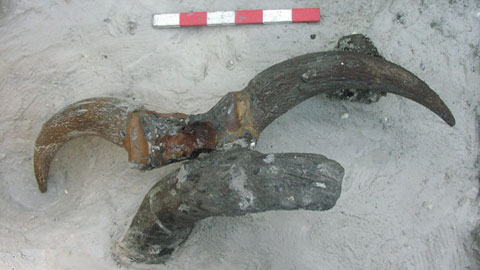Bowhunting may have fostered social cohesion during the Neolithic

02/02/2015
"Comparing the scarce remains of wild animals and the abundant hunting gear found in the site, we conclude that nutrition was not the main aim of developing hunting objects. Neolithic archery could have had a significant community and social role, as well as providing social prestige to physical activity and individuals involved in it", explains the researcher Xavier Terradas, from the Milá i Fontanals Institution (IMF-CSIC).
According to the study, in some cases, prestige was linked to the type of hunted animal and, at other times, had more to do with the distribution of the prey than with the capture of the animal itself. Raquel Piqué, UAB’s researcher, adds: "As a collective resource, larger preys may have played an important role, even in those cases when they constituted a punctual or sporadic resource".
The earliest European Neolithic bows
Among the material included in the study, there are three yew bows found in La Draga in 2012. The analysis of the pieces confirms that they have an estimated age of between 7,400 and 7,200 years old, the oldest of their kind found in Europe so far.
The only of the three bows completely recovered has a length of 1080mm, a maximum width of 25mm, and a thickness of 15mm. These dimensions are lower than the average for the rest of Neolithic bows found elsewhere in Europe. However, the dimensions of the conserved parts of the other two found in La Draga make researchers assume that they were larger, similar to the European ones.
The study concludes that the bows recovered in La Draga, besides being unique material documentation of early Neolithic archery and hunting technology, become part of the earliest archaeological evidence available on the social role of hunting in the first farming societies, especially in order to evaluate structural aspects such as economic specialization, division of labour and the nature of resource access.
Raquel Piqué, Antoni Palomo, Xavier Terradas, Josep Tarrús, Ramon Buxó, Àngel Bosch, Júlia Chinchilla, Igor Bodganovic, Oriol López, Maria Saña. Characterizing prehistoric archery: technical and functional analyses of the Neolithic bows from La Draga (NE Iberian Peninsula). Journal of Archaeological Science. DOI: 10.1016/j.jas.2015.01.005.
Images. Credits: MACB-UAB-CSIC-MAC
Bow recovered from La Draga in 2012. Of the three bows discovered, this is the only one which has remained intact.
Bucranium recovered from the site and corresponding to the now extinct urus which was hunted during the Neolithic period by the community at La Draga.
Silex and bone projectiles used at La Draga for hunting purposes.